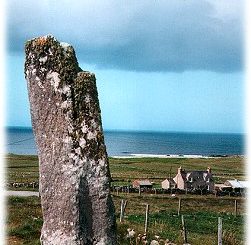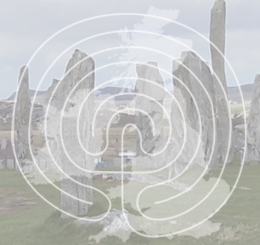The Arcane Landscape In Suffolk Revealed
History, the ritual landscape and geometry once resonated very much as one. Faint traces of our ancestors whose silent whispers in the landscape once conveyed so much awe and splendour now sadly lie silent, their purpose and meaning largely forgotten, for in general there is a present day lack of any real sense of connectedness. This compounds our ability to relate – be it to the environment – through the seasons, the cosmos – through the heavenly bodies or to our community through a neighbour. For far away from the mind boggling complexity of the pyramids of Giza, yet equally compelling, sit seven sites of mythic antiquity whose geomantic and geometric design collectively creates a beautiful and vast heptagon in the landscape.
‘Mathematical geomancy….does not mean the imposition of abstract designs upon the landscape, but the detection and enhancement of the geometry that is already concealed within it’ (Behrend, 1975 ).
Over a decade later I learned that the landscape symbol I discovered had been employed by our forefathers before whilst plotting their temples and markers in the landscape of Southern Britain ( Behrend, 1975 ), consciously created and designed to personify a harmonious fusion between temple proportion, the Earth’s circumference and ancient units of measure. In the early 1900’s Sir Norman Lockyer studied ancient alignments and the astronomical significance at Stonehenge. As well as traditional straight line alignments across the landscape Lockyer discovered an equilateral triangle whose three points ( Stonehenge , Grovely Castle hill fort and Old Sarum hill fort ) were all exactly 9.656 kilometres from each other. In more recent times David Furlong ( Keys to the Temple, 1997) a phenomenal circle of megalithic and largely Christianised pagan sites, also with this same 9.6 km factor. Only this time it was the radius of the circle. The symbol I have discovered in Suffolk, centring on Bury St Edmunds is identical in size to these proportions; at 19,149 metres across (nearly 12 miles) it is only 4 metres out from the size of the twin circles of ancient sites on the Marlborough Downs. The landscape heptagon includes ancient Neolithic earthworks, a long barrow, standing stones and the only location in East Anglia, I believe, where all the three ancient track ways (the Icknield Way – the oldest road in Britain , Peddars Way and the Puddingstone Track, whose origins date as far back as 6,500 B.C. ) coalesce.
It is only now that we are beginning to truly recognise that our European Bronze age ancestors showed the same remarkable levels of sophistication and civilisation as that of the ancient Egyptians and cultures of the Middle East . It was only forty years ago that we equated ancient history with that of classical Greece ( the curriculum at Cambridge, USA , Freer, 2000 ). And it was just over 300 hundred years ago that state of the art scholarship of the time was teaching that the creation of the world began at 4004 B.C. ! ( James Ussher, Irish Protestant bishop in 1654 ). On the whole still, even today when we stare back into the face of history we perceive a decrease in cognitive ability, incrementally a greater deficit the further back in time we go. It is us who have evolved in harmony with the forward and progressive passage of time becoming far more superior than our ancestors. The reality is though that the more we understand about our ancestors through their temples and artefacts our interpretations and the dating for mankind’s capacity and ability to be able to relate to our world on a more complex and sophisticated symbolic level of understanding is increasingly being questioned and pushed further back in time. There has been found to exist within the scientific community the process of what has been described as ‘knowledge filtration’ ( Cremo & Thompson, 1999 ). The authors document clearly in their ‘Hidden History of the Human Race’ numerous examples of archaeological evidence which have either been knowingly bypassed or ignored in order to protect this ruling paradigm when such evidence fails ‘to fit’ the accepted theory. ‘At the heart of this argument is the incorrect notion that theory overrides evidence’ ( Boerner, 2003 ). The chronology for and possible dating of the acquisition of this ‘civilised’ world view is continuously being rewritten, as alluded to earlier, brought about by such discoveries as :
1 – Scientific American reported that a 75 metre wide circle near Goseck in Germany is the remains of the world’s oldest observatory, dating back 7,000 years and is the first circle whose function is evident ( Mukerjee, 2003 ).
2 – Evidence in France at Lascaux also shows that our ancestors as long ago as 14,00 – 27,000 BC had already developed a sophisticated preoccupation with the phases and movements of the moon at this time.
The earliest written astronomical records possessed a preoccupation with the risings and settings of objects against the horizon, measuring the duration’s of time between these and other such ‘heavenly’ acts. This preoccupation with celestial events is believed to be connect with the cycles of vitality and fertility of the Great Mother Goddess through the stellar and solar events, which in turn affected her ( Broadhurst & Miller, 1989 ). We know our ancestors were capable of transporting and erecting approximately 10,000 megaliths, some up to 30 tons in weight at the same time as the 5th dynasty Egyptian pharaohs who were erecting their own seven major pyramids. At Avebury in Wiltshire the same volume in chalk as that of those seven major pyramids was being excavated – around 90,000 cubic metres ! ( Burl, 1979, Furlong, 1997 ). These ‘Stoneage’ ancestors were also capable of maintaining a standard unit of length : megalithic yard of 2.72 ft, from one end of England to the other, all with a margin of error of only 0.1 % ( Thom, 1967 ). It is no coincidence that they chose these numbers to represent their sacred canon for the ratio between the dimensions of the earth and the moon is 10 : 2.7272 – volumetric mean radius 0.2727 km . The ratio between these planets and their inherent geometrical proportions equals the megalithic yard of 2.72 feet and is very close to the 2.718…of energy constant e, e being the rate at which anything doubles, from plant growth to bank interest. These ancient monuments on the surface of the earth were not only erected to discover the patterns of behaviour of our celestial neighbours ( the major planets and stars ) but were also designed in such a way as to embody those patterns, already known in what has been described as a ‘religious architecture’ ( North, 1996 ).
At least one thousand years before the earliest mathematicians of classical Greece SAM ( stone age man ) had a competent working knowledge of geometry and was capable of setting out elaborate stone circles in a variety of ellipse shapes based on at least three of the different Pythagorean triangles- 3,4,5, – 12, 35, 37 and 5, 12, 13 ( Thom, 1967 ) all with a proficiency only rivalled today by a trained surveyor. Temples such as Stonehenge were founded on this relationship i.e. the width of the lintel stones being exactly one Jewish Rod – 3.4757485 ft, a unit of measure equal to one six-millionth part of the Earth’s polar radius. The ancient science behind this embodiment of number was once inextricably bound up with a world view containing science, religion and magic, the mastery of which would have been central to the priesthood’s ability to perform and carry out the necessary geomantic skills needed for locating a particular sacred site.
We now appreciate that individual ancient sites and collective structures carried profound psychological meaning to our prehistoric ancestors. Round barrows served to symbolically ‘represent the wider landscape in architectural form’ ( Watson, 2001 ) and were believed to represent the centre of the world, or even cosmos ( Richards, 1996 ). These great monuments were built to influence the way people experienced the landscape and how they were configured serving to structure the ways that people understood both space and time. Even mainstream archaeology is embracing ideas now which a decade ago would have seemed fringe and ‘new-age’ which appeared In the Journal of British Archaeology ( March, 2004 ). There it is acknowledged that the plan of the three henges at Thornborough in Yorkshire was designed to be an exact mirror of the three main setting stars in the belt of the constellation of Orion between 3,300 – 3,000 B.C.
Our own internal rhythms interact with the Earth’s low frequency isoelectric field, the magnetic field and our own electrostatic field, affecting our balance, REM sleep patterns, health and mental focus. We live amongst a complex matrix of oscillating fields within which life has evolved over many epochs. Minute fluctuations in one interlocked field have cosmic ramifications upon others. Many times per second the pulses of these fields circumnavigate the globe between our planet’s surface and the ionosphere ‘sending co-ordinating signals to all organisms’. These signals connect us to the global electrostatic field, the Schuman’s resonance ( SR ) which has been described as the orchestrating pulse for life on our planet ( Miller & Miller, 2003 ) and have been known to ‘reactivate stalled healing processes, enhance growth, accelerate immune responses’ ( Sidorov, 2001 ).
There is a consistent connection demonstrated between frequency, wavelength, energy transference and the arcane landscape. In a world of ‘dumbing down’ reality TV it is possible to reconnect, reconfigure with the infinity within ourselves. I see the heptagon in “Seven Wonders – Suffolk’s Ancient Sites : a Vision of an Arcane Landscape”, whose geometry is closely bound to the circumference of the Earth and to the wavelength of those frequencies which circumnavigate it as a vehicle for doing so and may your god(s) and goddesses guide you well on your way.
To learn more please visit www.lulu.com/spotlight/arcanelandscape




Re: The Arcane Landscape In Suffolk Revealed
Mr. Taylor fluidly writes about so many amazing, interconnected facts that I was astounded. I was familiar with some of them, but many were new to me. And, I was not aware that they were connected with each other, until I read this article.
Were you aware that archeologists found a megalithic complex at Gobekli Tepe, thought to be 11,000 years old, or older? (Please see http://www.huffingtonpost.com/2008/11/09/worlds-oldest-temple-disc_n_142417.html)
Thank you so much for shariing all of this information with us.
Re: The Arcane Landscape In Suffolk Revealed
Suffolk holds antiquity to the dawn of humanity – the county has yielded many delicate Palaeolithic records. Indeed one of the sites at Hoxne gave the name to the Hoxnian Interglacial period of balmy weather around 427,000 to 364,000 years ago.
The county has no rock to speak of, so megalithic remains are particularly sparse, in contrast to the fabulous richness of its historic heritage. As a result, if it is prehistory writ large in standing stones you are after, it has to be said Suffolk may disappoint compared to other regions.
The prehistory of the county is understated but ancient almost beyond comprehension, stretching back nearly half a million years to when humans competed with tropical creatures. On the banks of a prehistoric river running eastwards to the sea in that distant past, someone fashioned this hand-axe found at Hoxne, on the border with Norfolk.
The Brecks in the north-west of the county has yielded many more lithic finds, and raw material was close to hand at the nearby Grimes Graves flint mines. Time Team joined a British Museum dig at Elveden Forest to discover a 400,000 year old flint knapping site on the banks of a prehistoric river flowing eastwards towards the sea, which was much further east that the modern coastline.
Many prehistoric barrows survived in the county until the twentieth century, where mechanised farming of the rich East Anglian soils seems to have destroyed about 80% of sites, in comparison with Victorian maps.
I really enjoyed your concise explanations. Just in this article you have bought so much together for me. So I have just purchased your book. I am from Suffolk and enjoy dowsing, so I am sure I will find the book fascinating. I’ll come back and comment if I have any questions or just want to say thank you.